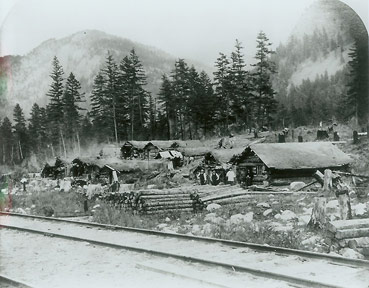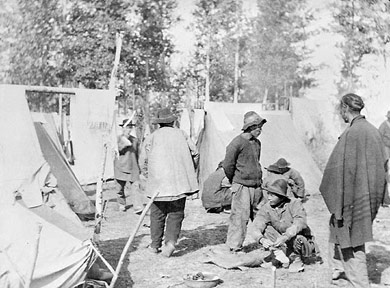Chinese Railway Workers
When British Columbia agreed to join Confederation in 1871, one of the conditions was that the Dominion government build a railway linking B.C. with eastern Canada within 10 years. .
A New York engineer was given the contract to build the portion of the railway from Port Moody to Eagle Pass, near Revelstoke, British Columbia.
The land in this area was mountainous, making the work difficult and dangerous. Workers were in short supply. Between 1881 and 1884, as many as 17 000 Chinese men came to B.C. to work as labourers on the Canadian Pacific Railway. The Chinese workers worked for $1.00 a day, and from this $1.00 the workers had to still pay for their food and their camping and cooking gear. White workers did not have to pay for these things even though they were paid more money ($1.50-$2.50 per day). As well as being paid less, Chinese workers were given the most back-breaking and dangerous work to do. They cleared and graded the railway's roadbed. They blasted tunnels through the rock. There were accidents, fires and disasters. Landslides and dynamite blasts killed many. There was no proper medical care and many Chinese workers depended on herbal cures to help them.

Chinese railway workers' log camp beside railroad
Construction of a Chinese camp on the Canadian Pacific Railway, Kamloops, British Columbia, circa 1885
The Chinese railway workers lived in camps, sleeping in tents or boxcars. They did their own cooking over open outdoor fires. They mainly ate a diet of rice and dried salmon, washed down with tea. With their low salaries they could not afford fresh fruit and vegetables, so many of the men suffered from scurvy (a painful disease caused by a diet without vitamin C).

A Chinese work gang for the Great Northern Railway, circa 1909
The camps were crowded. Diet and living conditions were poor. Many got sick. In the winter it was very cold and the open fires were the only way of keeping warm. Whenever the workers put down more tracks, the camps had to be moved further down the line. When it was time to move camp, the Chinese workers would take down their tents, pack their belongings and move everything to the next camp, often hiking over 40 kilometers.
Source: Library and Archives Canada



